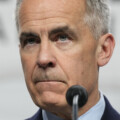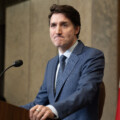Vladimir Putin’s invasion of Ukraine is about many things: geopolitical paranoia; a belief that Ukraine is rightful “Russian” territory; personal resentment; and even hardline religious zealousness. But perhaps his most terrifying objective is to sow doubt and discord within Western democracies; to test the NATO alliance. He believes that democratic values within the West, including Canada, are especially vulnerable right now. Is he right?
For the past few years, many observers have been bracing themselves for a populist explosion in Canada and wondered about the form it would take. As the dust from the trucker protests finally begins to settle, it appears the time for bracing is over: the protests mark an awakening and a maturing of far-right, anti-democratic populism in Canada.
Populism is rage against the machine made political. It flourishes when ordinary people feel ignored, isolated, uninspired, economically constrained, and perceive an elite economic and political class as the cause of their frustration. And perhaps, most especially, when they do not see the democratic system working for them. As a result, they eschew liberal democratic norms—delegitimize election results, attack journalists, and deny the truth of basic facts and science. While contemporary populist movements have taken on abhorrent racial and cultural dimensions (think of the Confederate flags that we witnessed in Ottawa), their genesis is often a breakdown in how polarized socioeconomic groups relate to one another—rich and poor, urban and rural, those with post-secondary education and those without.
These kinds of breakdowns became obvious in the UK in 2015, with Brexit, and in the U.S. in 2016, with the election of Donald Trump. But the groundwork was laid years before. Several decades of widening economic inequality reduced upward mobility. A creeping crisis of housing affordability and increasingly technocratic political leadership that tells us to leave major policy decisions to the experts have left ordinary people feeling helpless. In Canada, despite year after year of low interest rates, housing affordability is the lowest it’s been since the 2008 recession and has declined rapidly over the past year. Indeed, one of the most important aspirations of many young Canadians—to own their own home—feels wildly out of reach. This affects the psyche not just of young families but also of their parents, neighbours, and friends and pushes them towards populism.
Then came the pandemic. The populist wave that swept through the United States, United Kingdom, and several democracies in Europe and Latin America was accelerated by governments taking unprecedented steps to shape their citizens’ day-to-day lives. While much of the professional class retreated to their large homes (or second or third homes), so-called essential workers—including truckers—risked their health to continue earning the same wages as before. We ought to keep this split reality in mind as we try to understand why so many blue-collar Canadians were inspired to leave their homes for several weeks to occupy downtown Ottawa in the middle of winter.
While the proximate causes of the protests are clear—frustration over a vaccine requirement affecting only those truckers hauling loads across the Canada-U.S. border— it would be a mistake to interpret the events in Ottawa as symptomatic solely of pandemic fatigue turned to anger and a populist awakening. It’s no coincidence that the causes of populism—the isolation, the ennui, economic uncertainty, and stagnation—sound precisely like the feelings we all have after two years of on-again, off-again lockdowns. The suspicion over vaccines and COVID-related public health measures mirrors the populist suspicion with the socio-political elite that has been building for years. And our ability to come face to face with one another, both literally and metaphorically, has been all but destroyed while we retreated into our physical and ideological corners.
In the U.S., populism has both fed and been reinforced by several ills: a far-right news media that long ago abandoned any claim to honest reporting; unchecked and unaccountable social media; the January 6th riot insurrection; and Donald Trump, to name a few. To date, the problem of populism has been felt more dramatically in the United States, but it’s foolish to think that Canada could not someday see its own Fox News, its own January 6th, its own Donald Trump. The consequences for Canada’s security and standing in the world would be severe.
As democratic values across the world are under attack, and as we emerge from the pandemic, Canadian political leaders must address not only the acute effects of the health crisis and lockdowns, not just the blockades we saw in Ottawa and at border crossings but also the underlying causes of populist rancour. But what is the antidote to populism? If there was a clear answer, someone would have implemented it by now. Nevertheless, I propose that progress, shared equally, is a good place to start.
Whether measured in terms of household income, innovation, democratic engagement, or personal satisfaction and happiness, people need to feel that they, and most people around them, are making progress; that they are moving forward in their lives, whatever that means to them. We need to ensure that the aspirations of regular Canadians—to find fulfillment through work, attain higher education if one wishes, and one day own a home—are within reach.
As political philosopher Michael J. Sandel has argued, “We live in an age of winners and losers, in which the odds are stacked in favour of the already fortunate.” Progress is not just the domain of progressives; any leader willing to centre the aspirations of ordinary Canadians can claim the mantle. Doing so will go a long way to proving Putin wrong: that free, liberal democracies, including Canada, are not vulnerable.
Recommended for You

Laura David: Red pill, blue pill: Google has made its opening salvo in the AI-news war. What’s Canadian media’s next move?

The Notebook by Theo Argitis: Mark Carney’s first major tests

The Weekly Wrap: Trudeau left Canada in terrible fiscal shape—and now Carney’s on clean-up duty

Ben Woodfinden: Lament for an ‘elbows up’ nation



